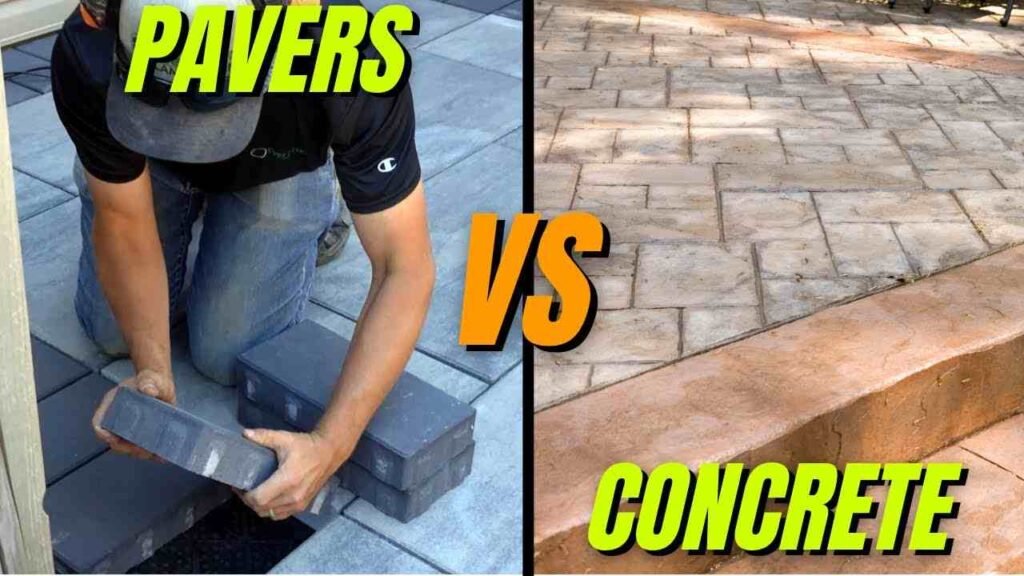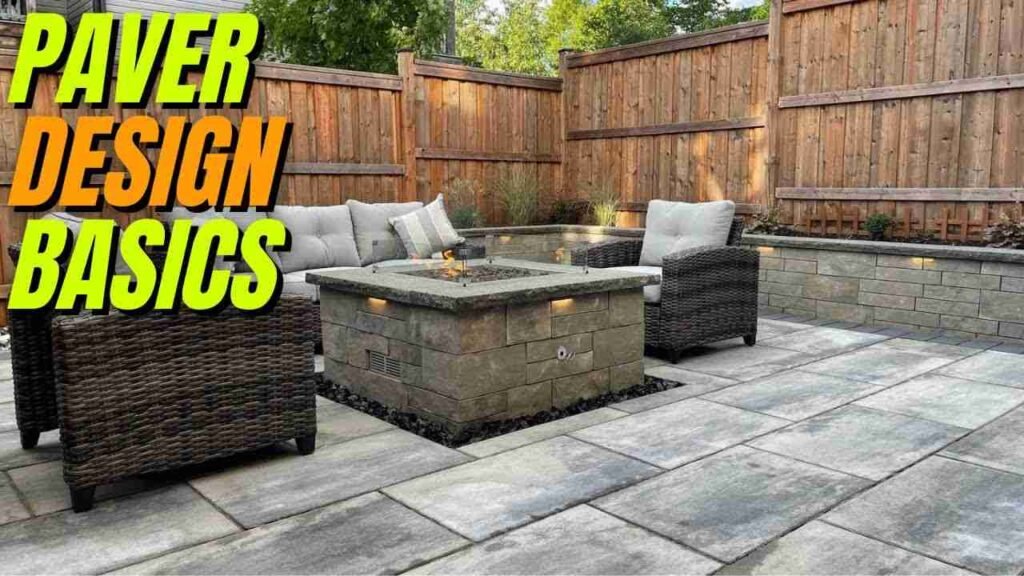When it comes to choosing the right hardscaping option for your outdoor space, two popular choices often come up: concrete and pavers. Both materials offer unique benefits, but they differ in terms of appearance, durability, and installation process. Concrete is known for its sleek, continuous surface, making it ideal for large areas like driveways or patios. Pavers, on the other hand, provide a more customizable look with individual stones or tiles that can be arranged in various patterns. In this guide and along with the help of Evergreen Landscaping of Cincinnati, we’ll break down the differences between concrete and paver hardscaping to help you make an informed decision for your project.

Each has its own maintenance requirements and cost considerations, which makes it important to weigh your options carefully. With hardscaping services, concrete may be more affordable upfront but can crack over time, leading to potential repairs. On the other hand, pavers are more flexible, allowing for individual replacements if damaged. The choice between these materials depends on your budget, the overall aesthetic you’re aiming for, and how much effort you’re willing to put into long-term maintenance. Collaborating with professional hardscaping services can help you navigate these options to create a durable and visually appealing outdoor space tailored to your needs.
Durability and Longevity of Concrete vs. Paver Hardscaping
Concrete and pavers both offer durable solutions, but their longevity varies based on material and installation quality. Concrete can last for decades when properly installed and maintained, but it’s prone to cracking over time, especially in areas with extreme weather. Pavers, on the other hand, are individual units, meaning that if one cracks, it can be replaced without disturbing the rest of the surface. Pavers also have a reputation for high durability due to their flexibility, allowing them to shift slightly without breaking. In the long term, pavers tend to outperform concrete in terms of repairability and adaptability, particularly in regions with shifting ground or frequent freeze-thaw cycles, making them a top choice for hardscaping features like patios and walkways.
Aesthetic Differences Between Concrete and Pavers
When it comes to aesthetics, both concrete and pavers offer a range of design possibilities, but the styles differ significantly. Concrete can be stamped, stained, or colored to mimic the look of natural stone or other materials, offering a clean and modern look. Pavers, however, come in various shapes, sizes, colors, and textures, providing more design flexibility. Pavers allow for intricate patterns like herringbone, basket weave, or circular designs, making them ideal for projects that require customization and visual appeal. While concrete may provide a seamless appearance, pavers often offer a more classic or traditional look, making them one of the best hardscaping materials for various climates, due to their ability to withstand temperature changes and ground shifts.
Installation Process for Concrete and Paver Hardscaping
The installation process for concrete and pavers varies in complexity, impacting not just the timeline but also the potential value of your property. Installing a concrete surface involves preparing the ground, building a framework, and pouring the concrete mixture, which is then smoothed and left to cure. This process is faster but requires precision to avoid cracking or uneven surfaces. Paver installation is more labor-intensive, as it involves laying a solid foundation of compacted gravel and sand, followed by individually placing the pavers. While concrete is quicker to install, pavers provide a higher degree of customization, ease of repair, and ultimately, can increase the value of your property with their attractive, durable finish.
Maintenance Requirements for Concrete and Paver Surfaces
Maintenance is a key consideration when choosing between concrete and pavers. Concrete requires periodic sealing to prevent staining and cracking, and over time, it may need patching or resurfacing if cracks develop. Pavers, by contrast, require less intensive maintenance, as damaged pavers can be replaced individually without disrupting the rest of the surface. Weeds can sometimes grow between paver joints, which might require occasional treatment or re-sanding. Both surfaces benefit from regular cleaning to remove dirt and debris, but pavers typically offer an easier maintenance routine. However, keeping paver joints well-sealed and properly filled is essential to prevent movement and keep the surface looking sharp.
Cost Comparison: Concrete vs. Paver Hardscaping
Cost is a significant factor when deciding between concrete and pavers. Concrete is generally more affordable upfront due to the simpler installation process and fewer materials involved. However, repair costs can add up over time if cracks appear or if resurfacing is needed. Pavers tend to have a higher initial cost because of the labor and precision involved in laying each individual unit, but their long-term repair costs are lower since you can replace damaged sections without redoing the entire surface. When weighing the cost, it’s important to consider both the initial expense and long-term maintenance to determine which option offers better value for your project.
Flexibility in Design: Concrete vs. Pavers
Pavers offer more flexibility in terms of design than concrete. With pavers, homeowners can choose from a variety of shapes, sizes, and colors, creating custom patterns that suit their style preferences. Pavers can be arranged in intricate designs that enhance the overall look of outdoor spaces. Concrete, while versatile, is limited to the shapes and textures that can be achieved through stamping or staining. Though concrete can mimic other materials, pavers allow for real three-dimensional depth and detailed patterns. Whether you prefer a sleek, modern look or a more traditional appearance, pavers offer more customization options for homeowners looking to personalize their space.
Weather Resistance of Concrete and Pavers
Both concrete and pavers offer strong resistance to weather, but their performance differs under certain conditions. Concrete is highly durable in most climates but may crack due to freeze-thaw cycles or extreme heat expansion. Pavers, on the other hand, can shift slightly in response to temperature changes, which reduces the likelihood of cracking. In areas with frequent temperature fluctuations, pavers often fare better because they allow for movement without compromising the surface’s integrity. Additionally, pavers have gaps between them that allow for better drainage, which can help prevent water pooling and subsequent damage. Overall, pavers tend to offer better weather resistance in extreme climates.

Repair and Replacement: Concrete vs. Pavers
When it comes to repairs, pavers have a distinct advantage over concrete. If a paver becomes cracked or damaged, you can simply replace that individual piece without affecting the rest of the installation. Concrete, on the other hand, is more challenging to repair. Cracks in concrete often require resurfacing or patching, which can leave visible marks. In some cases, large sections may need to be replaced, which can be costly and time-consuming. Pavers also allow for easier expansion or modification of the hardscaped area, whereas altering a concrete surface often involves cutting and repouring, adding to the complexity of repairs.
Environmental Impact of Concrete and Paver Hardscaping
The environmental impact of your hardscaping choice is an important consideration. Pavers are often seen as the more eco-friendly option because they are permeable, allowing water to pass through and reducing stormwater runoff. This feature helps maintain natural water cycles and minimizes the risk of erosion or flooding. Additionally, many paver materials are made from natural stone or recycled products, making them a sustainable choice. Concrete, on the other hand, is impermeable and can contribute to water runoff, potentially leading to drainage issues. The production of concrete also generates higher carbon emissions compared to paver manufacturing, making pavers a greener option overall.
Best Applications for Concrete and Paver Hardscaping
Both concrete and pavers have ideal applications depending on your project goals. Concrete is best suited for large, smooth surfaces like driveways, patios, or walkways where a seamless, modern look is desired. Its ability to be poured into specific shapes makes it a good option for customized designs that require precision. Pavers, however, are perfect for projects where design flexibility and intricate patterns are important, such as garden paths, decorative patios, or pool decks. Pavers also work well in areas that experience shifting soils or require easy repairs. The best choice depends on your specific needs, aesthetic preferences, and the intended use of the hardscaped area.
Which Option Offers Better Long-Term Value?
The long-term value of concrete vs. pavers depends on various factors, including initial cost, maintenance, and durability. Concrete is more cost-effective upfront but may require costly repairs if cracks or surface damage occur over time. Pavers have a higher initial investment due to labor-intensive installation, but they offer greater longevity with fewer repair needs, especially since individual units can be replaced easily. In terms of aesthetics, pavers provide more design flexibility, enhancing property value with their customizable appeal.
Conclusion
In conclusion, choosing between concrete and paver hardscaping ultimately depends on your priorities, whether they are cost, design flexibility, maintenance, or long-term durability. Concrete offers a more affordable, seamless option ideal for large, flat surfaces, while pavers provide versatility in design, easier repairability, and better adaptability to shifting terrain or weather conditions. Pavers may require a higher initial investment but tend to offer greater long-term value due to their durability and ease of maintenance. By weighing the pros and cons of each material and considering the specific needs of your outdoor space, you can make an informed decision that enhances both the functionality and aesthetic appeal of your property for years to come.
FAQs
Which is more affordable: concrete or pavers?
Concrete is generally more affordable upfront, but pavers may offer better long-term value due to their durability and ease of repair.
2. How long does concrete vs. paver hardscaping last?
Both can last for decades, but pavers often outlast concrete, as they are less prone to cracking and can be easily replaced if damaged.
3. Are pavers harder to maintain than concrete?
Pavers require more regular cleaning and weed control, but concrete may need more frequent repairs if it cracks.
4. Can I install pavers over an existing concrete surface?
Yes, pavers can be installed over concrete, but it requires proper preparation and drainage considerations.
5. Which option offers more design flexibility?
Pavers offer more design options with various colors, shapes, and patterns compared to the typically uniform look of concrete.
